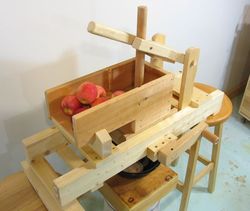Building an Apple Grinder (2003)
Having earlier experimented with Pressing
without grinding, I knew grinding the apples before pressing
is essential for extracting the juice.
My parents have been making apple cider for the
past five years or so, first using equipment borrowed from a neighbor. I
gave my press to my parents and my dad ended up rebuilding
it completely, only reusing the jack. So he had his own press. The grinder was
still one borrowed from a neighbor every time. But this cider making
occasion (fall of 2003), those neighbors were traveling, and the grinder was not
available to borrow.
They experimented with slicing the apples using a cabbage
slicing contraption, but that didn't yield very much juice.
They ended up running the apples through a kitchen style meat grinder,
but that was too slow so my mom instructed me to go find an apple grinder for them.
Having looked into this before, I knew they were not
commonly available, and if they were, they were quite expensive and not terribly
sophisticated. So I decided to try to build one myself.
Experimental design, and construction
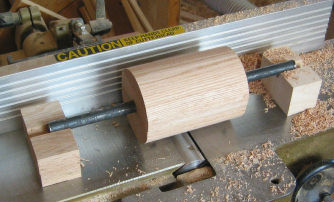 The core of my grinder design consists of a drum that essentially scrapes the apple to
bits. I made this drum by screwing two very thick pieces of oak (cut from
firewood) together. I cut a slot in both pieces with the table saw before attaching
them together to accommodate the shaft. That way, I didn't have to
worry about attempting to drill a straight hole that deep.
The core of my grinder design consists of a drum that essentially scrapes the apple to
bits. I made this drum by screwing two very thick pieces of oak (cut from
firewood) together. I cut a slot in both pieces with the table saw before attaching
them together to accommodate the shaft. That way, I didn't have to
worry about attempting to drill a straight hole that deep.
I didn't have a good way of mounting the drum and 5/8" shaft on
my lathe. But I had the idea of supporting the shaft on the jointer and
sliding the drum along the shaft. Each time rotating it slightly so eventually
cutting a perfect cylinder. I ended up with a cylinder of 107 mm in diameter and
160 mm long. I made it that size because it was the largest drum I could make from
the wood I had. The exact size is not that important, as long as it's
bigger than the biggest apples.
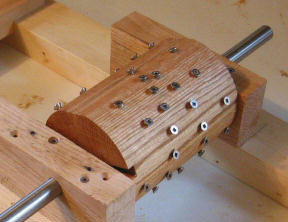 For the shaft in the actual machine, I used a smooth stainless steel
shaft from a monstrous 1970's era electro-mechanical faxsimile machine.
For the shaft in the actual machine, I used a smooth stainless steel
shaft from a monstrous 1970's era electro-mechanical faxsimile machine.
I put a stainless steel screw through a hole I
drilled in the shaft to couple the drum to it.
The screw goes in a slot at the end of the drum. In the photo at left,
you can see part of the slot on the
near side of the picture. When drilling a hole in a stainless steel shaft, grind
a small flat spot, then center punch that, and then drill in a drill press.
Otherwise, your drill will keep slipping off the curvature of the shaft.
I put a lot of stainless steel countersink wood screws
in the drum, each screwed in at an angle so that one edge of the countersink
would cut into the apple. Originally I figured I might want to sharpen the
edges of the screws, but this turned out to be unnecessary.
For the bearings, I just ran the shaft thru a 5/8"
hole in oak. I brass bushings would have been good, but a steel shaft
running thru an oiled piece of oak is actually fairly durable.
The bearing blocks do come apart at the hole for oiling with
vegetable oil. Wouldn't want to use machine oil on something that gets
close to food. I know oak is not too bad for food contact and it withstands
rot fairly well. Nevertheless, I drenched the drum and blocks in olive oil
just to keep the juice from soaking into the wood.
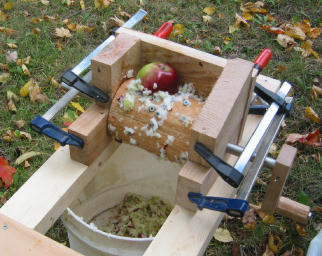 Having built it this far, it wanted to validate the
concept of grinding apples this way. I attached a crank to one end of the
shaft and jigged up a box with some bar clamps. I then ground up a couple
of potatoes (having no apples handy), and it worked quite well. I then
bought a bag of eating apples from the store and ground a few of those up too,
right on top of the potato grounds. It worked pretty good, and
didn't need that much effort to crank it. The apple ground away pretty
quickly too.
Having built it this far, it wanted to validate the
concept of grinding apples this way. I attached a crank to one end of the
shaft and jigged up a box with some bar clamps. I then ground up a couple
of potatoes (having no apples handy), and it worked quite well. I then
bought a bag of eating apples from the store and ground a few of those up too,
right on top of the potato grounds. It worked pretty good, and
didn't need that much effort to crank it. The apple ground away pretty
quickly too.
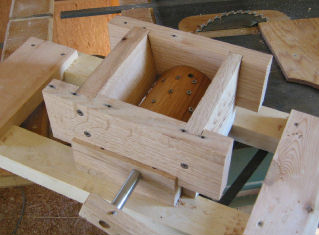 The next step was to build a sturdy housing for the
grinder. I used some oak wood from discarded palettes. It had some nail holes
in it but that didn't matter too much for a very utilitarian contraption.
The next step was to build a sturdy housing for the
grinder. I used some oak wood from discarded palettes. It had some nail holes
in it but that didn't matter too much for a very utilitarian contraption.
I only made the housing immediately around the drum out of oak. For the
funnel, I used 1" thick pieces of white pine - the funnel doesn't do the
grinding, so it doesn't need to be super sturdy. I also switched to less
expensive deck screws for the parts not immediately surrounding the grinding drum itself.
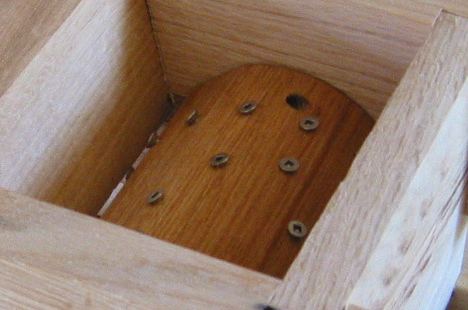 Note how little the screws stick out of the drum. This much protrusion actually
already does plenty of cutting. The less the screws protrude, the finer
they grind the apples. The screws are all slightly angled so that the leading edge
of the countersink head sticks out a bit more, so that it acts a bit like a cutter.
Note how little the screws stick out of the drum. This much protrusion actually
already does plenty of cutting. The less the screws protrude, the finer
they grind the apples. The screws are all slightly angled so that the leading edge
of the countersink head sticks out a bit more, so that it acts a bit like a cutter.
Hand cranking a grinder for a hundreds of kilos of apples is a
lot of work, even with an efficient grinder design, so my plan was to
motorize this contraption all along. At this point, it was thanksgiving
day, and I couldn't shop for a big pulley to mount on the shaft. I wanted
a really big pulley so the drum wouldn't run too fast. I didn't want
it to run it so fast as to throw bits of ground bits of apple back out the top
of the funnel.
I cut the pulley from a scrap of 1" plywood.
I rounded it on the table saw, by drilling a small hole in the
middle, a nail thru that into another piece of plywood, and that on the sliding
table of the saw, making successive cuts until it was nearly round, then
spinning the disk as I moved it slowly past the blade.
The V grove for the belt I also cut on the table saw, by
making a series of continuous cuts around the pulley (careful when you do that,
it can be accident prone, especially for smaller pulleys).
For the motor, I used a utility motor that actually belongs to a lathe. This
had a stepped pulley, which came in handy.
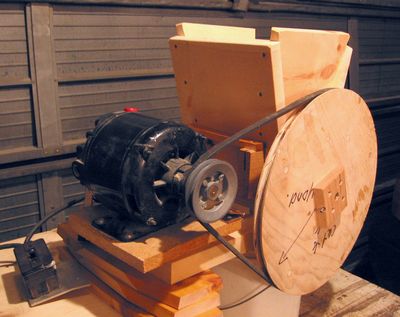
I then ground up the remainder of my bag of
apples. To make the pulp finer, I had turned the screws further into the
grinding drum. That made it grind slower so I increased the speed
by going to the next step on the motor's pulley. It was a four
step pulley. On the picture on the right, you can just see the largest of the four
pulleys on the motor, much bigger than the one the belt is actually on.
The whole idea is not so much to cut the apples, as to mash the pulp as much as possible,
crushing the cells in the apples. It's the grinding that frees up the
juice, and pressing is just a matter of wringing the liquid out of the pulp.
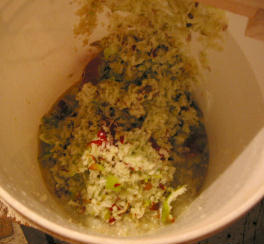
Fresh ground apples.
They turn dark relatively fast after grinding
Testing the mash for juice extraction
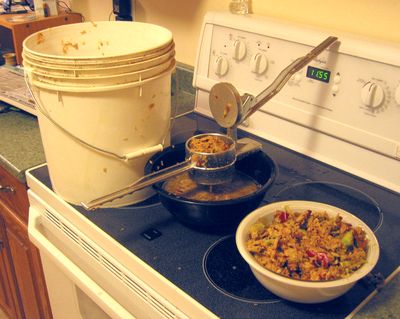 I no longer had the press I had built in 1999,
but I still wanted to see how much juice could be extracted from the apples,
ground apples were. I had paid good money for them
at the grocery store, and it would have been a pity to just throw them
out without getting some further use out of them.
I no longer had the press I had built in 1999,
but I still wanted to see how much juice could be extracted from the apples,
ground apples were. I had paid good money for them
at the grocery store, and it would have been a pity to just throw them
out without getting some further use out of them.
So I took the bucket in the kitchen, and proceeded to squeeze them with my
späzle press. A späzle press is a lot like a heavy-duty potato mincer, but with
fewer and smaller holes, and cast out of solid aluminium.
More solid than a potato mincer, it still couldn't apply nearly the kind of
force that a six-ton hydraulic jack could apply. I squeezed everything one
small portion at a time into a bowl, and got 1.40 liters. I then took the
resulting leftover pulp and squeezed it again, and got another 0.12
liters. I ran the juice thru a fine sieve, but did not filter it in any
way, so it wasn't terribly clear. Did very much taste like fresh apple
juice. This is important - my grinder and the oiling I gave it did not
impact the taste of the resulting juice.

I wanted to see how well I did overall. I weighed the remaining
pulp before the second squeezing at 1.40 kilograms. Subtracting a further 120 grams
for the juice from the second squeeze, I had the apples broken down into:
Extracted liquid 1.52 kilogram
Remaining pulp 1.05 kilogram
So I was able to extract 59% of the apples weight in juice. I
baked the remaining pulp to see how much more liquid was in it. After
150° C for two and a half ours, I was left with 185
grams of solids. Thus, 0.185/(1.52+1.10) = 0.0719. So the the apples
are 7.2% non-water, or about 92.8% water. But that's counting the juice
as all water, which it isn't entirely.
I was pretty happy with the juice yield. Even without a powerful press
I got way more juice than I did with my press and no grinding.
It's not how you squeeze the apples, it's how you grind them
that determines the juice yield.
 The core of my grinder design consists of a drum that essentially scrapes the apple to
bits. I made this drum by screwing two very thick pieces of oak (cut from
firewood) together. I cut a slot in both pieces with the table saw before attaching
them together to accommodate the shaft. That way, I didn't have to
worry about attempting to drill a straight hole that deep.
The core of my grinder design consists of a drum that essentially scrapes the apple to
bits. I made this drum by screwing two very thick pieces of oak (cut from
firewood) together. I cut a slot in both pieces with the table saw before attaching
them together to accommodate the shaft. That way, I didn't have to
worry about attempting to drill a straight hole that deep.
 For the shaft in the actual machine, I used a smooth stainless steel
shaft from a monstrous 1970's era electro-mechanical faxsimile machine.
For the shaft in the actual machine, I used a smooth stainless steel
shaft from a monstrous 1970's era electro-mechanical faxsimile machine.
 Having built it this far, it wanted to validate the
concept of grinding apples this way. I attached a crank to one end of the
shaft and jigged up a box with some bar clamps. I then ground up a couple
of potatoes (having no apples handy), and it worked quite well. I then
bought a bag of eating apples from the store and ground a few of those up too,
right on top of the potato grounds. It worked pretty good, and
didn't need that much effort to crank it. The apple ground away pretty
quickly too.
Having built it this far, it wanted to validate the
concept of grinding apples this way. I attached a crank to one end of the
shaft and jigged up a box with some bar clamps. I then ground up a couple
of potatoes (having no apples handy), and it worked quite well. I then
bought a bag of eating apples from the store and ground a few of those up too,
right on top of the potato grounds. It worked pretty good, and
didn't need that much effort to crank it. The apple ground away pretty
quickly too.
 The next step was to build a sturdy housing for the
grinder. I used some oak wood from discarded palettes. It had some nail holes
in it but that didn't matter too much for a very utilitarian contraption.
The next step was to build a sturdy housing for the
grinder. I used some oak wood from discarded palettes. It had some nail holes
in it but that didn't matter too much for a very utilitarian contraption.
 Note how little the screws stick out of the drum. This much protrusion actually
already does plenty of cutting. The less the screws protrude, the finer
they grind the apples. The screws are all slightly angled so that the leading edge
of the countersink head sticks out a bit more, so that it acts a bit like a cutter.
Note how little the screws stick out of the drum. This much protrusion actually
already does plenty of cutting. The less the screws protrude, the finer
they grind the apples. The screws are all slightly angled so that the leading edge
of the countersink head sticks out a bit more, so that it acts a bit like a cutter.


 I no longer had the
I no longer had the 
